Last updated 11.8.07
|
Information - Postal Services
Last updated 11.8.07 |
Hartley Post Office
Hartley Post Office and
Fairby Stores is located in Ash Road near the junction with
Culvey Close. In
the 2005 Parish Plan questionnaire, the Post Office was
the highest rated service among those who used it. Hartley Post Office is
open the longest of all local sub-post offices, and they also run a satellite office at Fawkham
on three mornings a week, which is greatly
appreciated by the
inhabitants there.
Local post offices are to be found at (information checked with Post Office August 2006):
|
HARTLEY |
Monday to Friday 9 - 5.30 |
|
LONGFIELD |
Monday, Tuesday, Thursday, Friday 9 - 1, 2 - 5.30 |
|
LONGFIELD HILL |
Monday, Wednesday, Thursday, Friday 9 - 1, 2 - 5.30 |
|
NEW ASH GREEN |
Monday, Tuesday, Thursday, Friday 9 - 1, 2 - 5.30 |
|
FAWKHAM |
Monday to Wednesday 9 - 11.30 |
Letter Boxes
Letter
boxes are located at (approximate date of erection in
brackets):
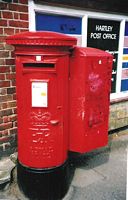
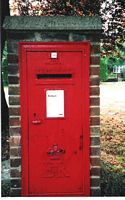
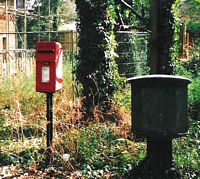
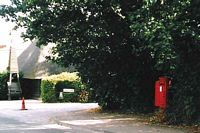
Some
of the letter Boxes in Hartley
Links
Royal
Mail
Postcomm - Postal Services
Commission (industry regulator)
Post
Office Counters
Postcodes
The postcode has been used locally
since the early 1970s to enable the Post Office to sort
mail more quickly (see British Postal Museum and Archive
Information
Leaflet). It is split into a number of elements,
eg. for DA3 8BL:
 Longfield Delivery Office, which delivers post to the DA3 area.
Longfield Delivery Office, which delivers post to the DA3 area.
History
Dartford has a long history as a post
town, going back to the 1630s, when the postmaster was paid
the sum of 1 shilling (5p) a day. The town was the
first stage for the post riders taking post from London
to Dover and the continent. Originally post was taken
by rider on horseback, changing horses at the stages, in 1635 the Dartford
postmaster said he needed 16 horses for the job. In theory the
post should have travelled at 7mph on the Dover Road in summer and 5mph
in winter. Thus post, which was despatched daily from Dover between
5 and 6pm should have arrived at Dartford at either 1am or 4am, but
in reality was much slower. Mailcoaches were introduced in 1784,
which increased the speed of the post to 7mph. The post left London
for Dover daily at 8pm and the return journey from Dover at 6.30pm.
The Saturday
Magazine (488kB Acrobat file) of 1 December 1832 gives a
good description of the Post Office in the days before railways.
 Post carriage (from Saturday Magazine, 1832)
Post carriage (from Saturday Magazine, 1832)
Our area was very isolated for the post, as there was no onward post delivery from Dartford, like there was for Sutton at Hone (from 1804), Greenhithe and Swanscombe (from 1830). People would have the choice of either collecting the post from Dartford or one of the receiving offices, or await delivery by carrier. In 1831 a number of London businesses complained about poor deliveries of their letters in the neighbourhood of Dartford, and in particular at Ash. The Post Office replied that the only real option was to send them to the receiver's house at Farningham and then collecting them or arranging with "some of the drivers of the Maidstone coaches or vans to convey them from thence". The Post Office was not unaware of the problems of delivery in this area, previously in 1828 but Mr Scott their officer found no "means, consistent with a due regard for the Revenue, by which the accommodation to the county can or might be increased". However Ash did get the first local office in 1846; post from London arrived at 11.30 am and the box for London closed at 2.10 pm.
In 1834 the owner of land in Green Street Green tried to get a regular penny post delivery there, complaining that it was wrong letters that reached Dartford "should then be left to the control and management of a tradesman in that Town, to be sent forward when suitable to his own convenience". The Post Office replied that as only 10 letters a day were addressed there (or 20 in the fruit and pea season), there was no justification for official deliveries.
By 1845 letters for Hartley and Longfield were sent from Dartford via a foot postman, and this was still the case in 1878. Likewise postal services could only be obtained from Dartford and Gravesend, although Longfield had a money order and savings bank office established in 1844. Longfield became a receiving office for letters sent via Dartford in 1891 with letters arriving at 7.45 am and 1.15pm daily. Shortly after (1893) Longfield became a post town with direct deliveries from London at 6.45am and 1.45pm, and collections at 11.50am and 7.45pm, while the office became a sub-post office for the first time.
From 1891 Hartley's letters came via Longfield, it appears that until 1911 when an 8am delivery was instituted, that people would have to collect their post from Longfield. Hartley finally got a sub-post office in 1914 with Herbert Noakes the first sub-postmaster. Deliveries from Longfield were at 8am and 2.30pm, the box there was cleared at 8am, 2.15pm and 7.20pm on weekdays and 10am on Sundays. However for money orders and telegrams you still needed to go to Longfield.
The volume of post has grown hugely in the last centuries. In 1828 just 170,802 letters per week were sent to London from all parts of the UK - far less than the number of letters delivered in the DA postcode area alone now. It is difficult to get an exact figure of volume of post at Dartford in the past because only the annual revenue was recorded. But about 8,000 letters annually were sent in 1750, rising to about 40,000 in 1800 and 60,000 in 1835. According to an undated leaflet from about 1980, the volume of post in the DA area was 800,000 letters posted and 1,150,000 delivered every week. The new Dartford sorting office was opened in 1975.
Further reading -
"English Provincial
Posts" (Brian Austen, 1978 - in spite of the title, it is mostly
about Kent).
British Postal
Museum and Archive website.
Post Office and Kellys Directories
1845 onwards
Post Office files in Dartford Library
Charges
Sending
a letter used to be much more expensive. The charges were based
on size and distance. To send a letter from Dartford to London
cost 2d in 1635, then 3d in 1711, 2d in 1765, 3d in 1784, 4d in 1796,
5d in 1812, and 4d in 1839 (these are about the equivalent of £1
in 1998 prices - see House of Commons Library - Inflation:
The Value of the Pound 1750-1998). Added to this for places like Hartley
and Longfield, would be the cost of carriage from Dartford, usually
at least another 1d. There were some expensive concessions for the Post
Office, MPs' letters and newspapers were conveyed free of charge. Thus
it can be seen how the national penny post in 1840 was greatly appreciated!
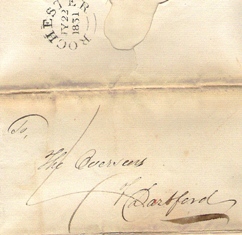
Letter
sent from Rochester to Dartford, 1831, note the 4d postage written on
the cover, just 9 years later the price would be 1d!